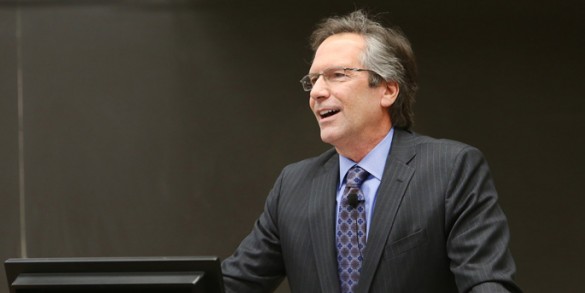
After weathering a challenging year of immense changes in the health care industry, Vanderbilt University Hospital and Vanderbilt’s adult clinics have emerged stronger and better poised for long-term growth.
David Posch, CEO of the adult hospital and clinics and executive director of Vanderbilt Medical Group, told those gathered at Light Hall on Tuesday that efforts to shore up the institution’s financial stability paid off and will allow Vanderbilt to improve quality and patient care.
“I stand before you saying that we are great and that the efforts we took, albeit necessary, have in fact created stability for the organization going forward,” Posch said during the “State of the Adult Enterprise — Driving Value” presentation, an annual talk on the state of Vanderbilt’s adult clinical enterprise.
Not only are the hospital and clinics financially stable, but during the past year they have thrived, Posch said, pointing to slides that showed how the clinical enterprise has beaten financial targets so far this year.
Also, surveys of patients show Vanderbilt to be the most preferred health care provider in terms of quality, which is supported by continued growth in volume that well exceeds what other health care organizations are experiencing.
Posch referred to efforts underway for more than a year to reduce $250 million from VUMC’s budget by the end of fiscal year 2015.
“What does this mean?” Posch asked. “We have to have sound financial performance so we can do all the things we really want to do as an organization. That really gets down to our fundamental mission and the patient care that we’re trying to provide.”
Going forward, like other health care providers in the country, Vanderbilt still faces challenges to providing cost effective quality health care.
Among the challenges is the need to continually improve coordination between clinics, increase adaptation of evidence-based standards, and enhance engagement with patients and families to make sure they’re on the same page, Posch said.
“I would submit that if we solve these problems, we take out at least 30 percent of the cost of health care and we improve all of the quality outcomes that patients are interested in,” he said.
The institution is moving forward on several initiatives to help address those challenges, particularly with how to better coordinate care for patients, Posch said.
The goal is to move from a model where the clinical care environment is very much centered on volume and isolated events to a model where patients are offered a coordinated system of care and are engaged to help better manage their illness, whether chronic or acute, he said.
Throughout the hospital and clinics, project teams are evaluating processes and trying to identify tasks that don’t add value or improve patient outcomes.
“We take a look at work processes — that spaghetti map of all the ways things are done — and we start asking the question, ‘Does each one of these steps best add value to our outcome?’” Posch said. “And if it doesn’t add value, get rid of it.”
Cutting out those processes not only reduces the cost of providing care but also helps to free up clinicians and other staff members to focus on providing even more and higher quality care, he said.
“That’s the good news about this,” Posch said. “Taking out that cost, taking out the unnecessary work, doesn’t mean that there’s less for us to do. There’s plenty for us to do. There’s just more opportunity to take care of people who want our service.”












